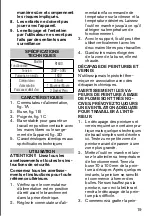
8
the OFF position before plug-
ging into the electrical outlet.
2. Set the power switch/tempe-
rature control to the desired
speed and temperature. Let the
tool run until it reaches opera-
ting temperature.
3. With the stand the tool can be
used in a vertical position with
both hands free for work.
4. Keep hands away from the im-
mediate nozzle area, it’s hot.
PAINT AND VARNISH REMOVAL
Never use the heat gun in combina-
tion with chemical strippers.
WARNING! LEAD PAINT FUMES
ARE VERY HARMFUL. ALWAYS
PROVIDE ADEQUATE VENTI-
LATION WHILE WORKING IN-
DOORS.
1. Removal of paint and varnish
requires some practice but
some simple working techni-
ques are described here. Test
on a small area of paint before
moving on to larger areas.
2. Turn on the tool and allow it
to reach working temperature.
Hold the nozzle 70 to 100 mm
from the paint to be removed.
After a short time the paint will
soften and begin to bubble.
Do not overheat the paint, as
this will cause burning and
make the paint more diffi cult to
remove.
3. Begin scraping the paint off.
Use accessory scrapers. Scra-
pe with smooth, even strokes,
warming the surface in front
of the scraper by moving the
tool slightly from side to side. If
paint is warmed properly, even
thick layers can be removed in
a single pass. Scrape the paint
as soon as it softens since it will
quickly harden again. Figure 3
4. Clean the edge of scraper
blade often.
5. Shaped or profi led surface can
be stripped with a wire brush
after softening with the hot air
tool.
6. Protect surfaces NOT to be
heated with non-fl ammable ma-
terial, Figure 4. Never concen-
trate tool’s heat on a window
panel or other glass surface.
Note: The heat gun is designed to
remove both oil and latex-based
paints and varnishes. It will not re-
move stain or primer coat that have
impregnated the surface of wood.
OTHER JOBS FOR THE HOT AIR
TOOL
1. Removing self-adhesive stick-
ers and trim.
2. Thawing frozen pipes, frozen
door locks, padlocks, etc. Fig-
ure 5
WARNING: Be very careful when
trying to thaw plastic pipes!
Pipes may melt.
3. Highlighting the natural wood
grain of wooden surfaces.
4. Fast drying of paints and var-
nishes.
5. Softening old putty before
removal and replacement.
6. Shrinking shrink wrap sheeting
for packaging protection.
7. Applying ski wax.
8. Shrinking shrink tubes on wire
joints.
9. Tin soldering of wire joints etc.
Содержание R1600
Страница 2: ...2...
Страница 3: ...3...
Страница 70: ...70 2 a 3 a...
Страница 71: ...71 4 a...
Страница 72: ...72 5 a 1 2 3...
Страница 73: ...73 4 5 6 7 8 9 R1600 230V 50Hz 1600 0 1 2 1 1A 2 1 3 1 4 2D 5 1 OFF 2 3 4...
Страница 74: ...74 1 2 70 100 3 3 4 5 6 4 1 2 5 3 4 5 6 7 8...
Страница 75: ...75 9 10 11 6 1 2 3 4 5 6 2012 19 CE 2 1 2 RAPID...
Страница 112: ...112 2 e 3...
Страница 113: ...113 off 4 c...
Страница 114: ...114 d f g 5 1 2 3 4 5 6 7 8...
Страница 115: ...115 8 9 R1600 230V 50Hz Watt 1600 0 OFF 1 Mid Mid 2 High Full 1 1 2 1 3 1C 4 2D 5 1 OFF 2 3 4 1 2 70 100 mm...
Страница 116: ...116 3 3 4 5 6 4 1 2 5 3 4 5 6 7 8 9 10 11 6 1 2 3 4 5...
Страница 134: ...134 GFCI GFCI 3...
Страница 135: ...4...
Страница 136: ...136 5 1 2 3 4 5...
Страница 137: ...137 6 7 8 8 9 R1600 230V 50Hz 1600 0 1 2 1 1A 2 1B 3 1C 4 2D 5 1 2 3 4...
Страница 138: ...138 1 2 70 100 mm 3 3 4 5 4 6 1 2 5 3 4 5 6 7...
Страница 139: ...139 8 9 10 11 6 1 2 3 4 5 6 2012 19 2 1 2 RAPID...
Страница 140: ...Mind Join 2020 02 27 Isaberg Rapid AB Metallgatan 5 335 71 HESTRA SWEDEN www rapid com...









































